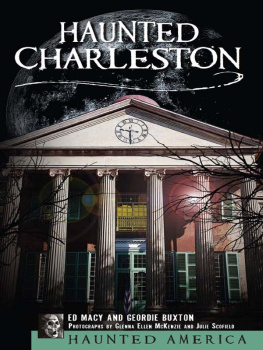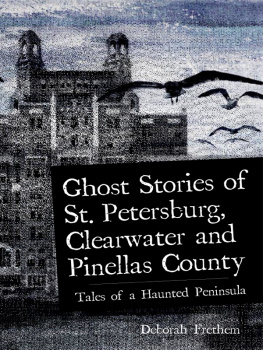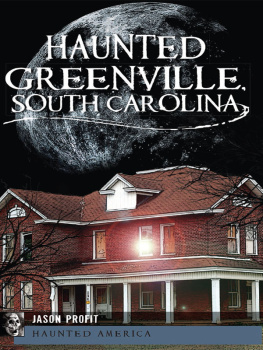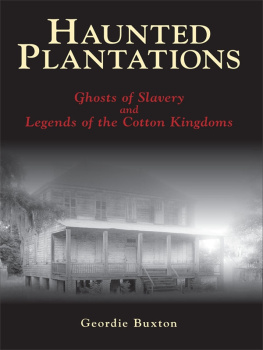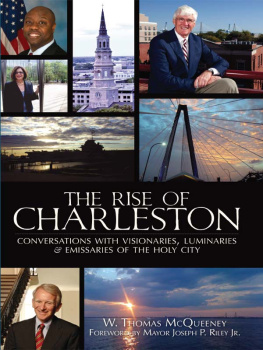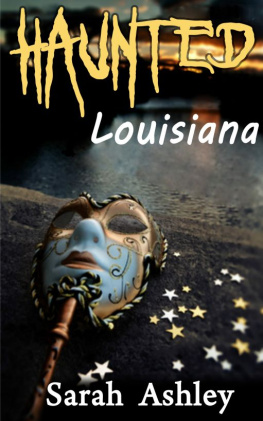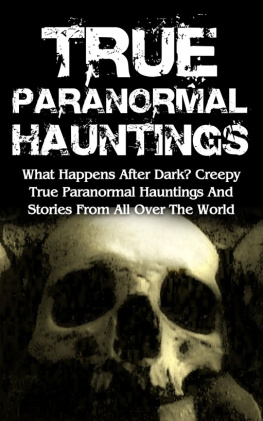

Published by Haunted America
A Division of The History Press
Charleston, SC 29403
www.historypress.net
Copyright 2004 by Ed Macy and Geordie Buxton
All rights reserved
First published 2004, Second printing 2005, Third printing 2006,
Fourth printing 2008, Fifth printing 2011
e-book edition 2012
ISBN 978-1-61423-321-3
Library of Congress Cataloging-in-Publication Data
Macy, Ed.
Haunted Charleston : stories from the College of Charleston, the Citadel, and the Holy
City / Ed Macy and Geordie Buxton.
p. cm.
Includes bibliographical references.
print edition ISBN 1-59629-011-0 (alk. paper)
1. Ghosts--South Carolina--Charleston. I. Buxton, Geordie. II. Title.
BF1472.U6M33 2004
133.109757915--dc22
2004025575
The names of some people involved in these stories have been changed either by their
request, or because their relatives have asked us to do so.
The poem Shadow in the Empty Eye was previously published as A Southern Adolescence Recognized in Musings of the Lowcountry, 1995; Garnet, 1995; New Millennium Writings, 2000 and Channel Surf, 2000.
Photo Credits
page 54 Post & Courier
pages 70, 90, 10809, 114 Laurens Smith
page 11213 Frank Ruopoli
Other photos courtesy of the authors.
Notice: The information in this book is true and complete to the best of our knowledge. It is offered without guarantee on the part of the authors or The History Press. The authors and The History Press disclaim all liability in connection with the use of this book.
All rights reserved. No part of this book may be reproduced or transmitted in any form whatsoever without prior written permission from the publisher except in the case of brief quotations embodied in critical articles and reviews.
CONTENTS
To my muse. You know who you are.
SHADOW IN THE EMPTY EYE
In this pale crescent moon, I see the angels cross over
With their ghost bombs and fresh winds, scattering
The heat lightening and droning clouds away
From my island home, steering the storms
Across the harbor where unheard rebel captains
are still murmuring below the watermark. Inside
its Battery sea walls, Charlestons spires grow
taller, and the lunatics and businessmen take shelter
In the shadows of the cobblestone alleys along East Bay.
A snowy egret, anchored in plough mud, rises
like a sleepy child and stretches out his wings
through the sharp blades of the marsh grass;
Above, hidden behind the mossy silhouettes
of Spanish oaks and the tall reviewing spires,
there are soft whispers of Gullah, glowing
in starry hints of blue and green and gold.
Those bright hushed voices haunt me now, and this
universe is falling fast like thunder to the watermark:
the moon has lit the egret on fire, and she blazes
momentarily over an unexpected flood tide.
Geordie Buxton
INTRODUCTION
This book covers new territory involving Charlestons ghostsliterally and figuratively. Few of these stories have ever been published, and they take place away from the average postcard shots of the city: the moss- and ivy-strewn campus of the College of Charleston, the imposing fortress of the original Citadel, and the neighborhoods that once lay near the boundary of the city. These stories and essays are more grim and morbid than the stories that have been published previously about the Holy Citys ghosts. In many cases, they are more tragic because of the age or the number of people involved. That is the face of history, and I cannot as a writer presume to make these stories more digestible. I must tell them as they happened and let the reader make his or her own decisions on how to accept them.
There is only one essential ingredient in a ghost story: death. Immediately upon discovering this, one realizes the topic at hand is inherently morbid. It is this high-speed train wreck fascination that keeps the reader or the listener attentive, alert and somewhat (hopefully) uneasy. Ghost stories exist not to fill the publics desire for morbidity or gore. They exist because these real events happened to very real people. These were living beings who died in wars, in pistol duels and in acts of God and Mother Nature. The dramatic suspense does not need to be embellished, because these things actually occurred.
Embellishment can and does thrive in ghost legends, however. These are the stories wrought from the human desire to become a slave to the storyteller. Often, but not always, these are tales of real events that have been padded or twisted to take on a whole new life. They can become part of the cultural subconscious. As a storyteller, I am not opposed to ghost legends. I simply feel they should remain in their proper category, and not passed off as ghost stories.
Unfortunately, this genre has already been victim to endless stereotyping and clich bombardments. The concept of the ghost as a chain-rattling, sheet-draped phantom is infuriatingly ingrained in our cultural heritage. The American Halloween culture did for ghosts what the Book of Genesis did for the snake: both cast their subjects in a light to be feared and even despised, when in fact there is no real justification for this.
Another element of stereotyping involves the ever-familiar famous ghost. I once heard a carriage tour guide tell a group of gullible tourists that General Robert E. Lee haunted the Mills House Hotel on Meeting Street. Now, granted, I do not know everything that went on in Lees personal life during his short stay at the hotel in the beginning months of the Civil War. But I can almost guarantee that nothing happened here to rival the emotion and psychic trauma the man endured years later on the battlefields of Virginia, Appomattox Courthouse or Arlington, his mansion-turned-cemetery. My point is that every city has a famous ghost. It is an epidemic we must endure, as the ghost genre gets more popular and more commercialized. People love to put the famous name to the not-so-famous ghost. Fame and notoriety sell. Its been proven.
This book contains ghost stories based on real history and specific details. There are no elements of mystery, intrigue or romance embellished to make for a more frightening story. Truth is stranger than fiction, meaning the natural and historical drama in these stories provides wonder. The specific details provide the almost shocking realism. Todays reader demands more than ambiguous, question-marked rhetoric, i.e.: and some believe the ghost still haunts the manor to this day. Do you?
There are many books that will provide readers with a false sense of mystery and adventure. The stories in these books are set in obscure, out-of-the-way locales, some of which do not even exist anymore. It may have worked in the early 1960s, but todays reader is far more jaded. They expect the details wrought from great scrutiny. John Bennetts Doctor to the Dead, while highly entertaining, is in a completely different genre. It focuses on cultural superstitions and orally translated folk-tales.
Haunted Charleston provides the significant dates, locations and names of these stories. We also range the readers senses in describing how the ghosts are experienced. All of our settings are real, extant and can be seen by the reader upon visiting Charleston.
I have been asked numerous times by television producers why Charleston has so many ghosts. For the first few nave years, my standard reply was its an old city that has seen a lot of death. Granted, this is true, but it could also be said for hundreds of communities on this continent. If asked today, I try to answer more philosophically. I now tell interested parties that the spirit world crystallizes around objects of familiarity. By law and common sense, Charleston has entire neighborhoods that have never changed physically. Not just the exteriors of the structures, preserved for the sake of historic importance and tourism, but even small details inside: doorknobs, light fixtures and, unfortunately in some, plumbing and electrical wiring. This city has changed dramatically in a cultural and social sense. The smell and view and placement of property, however, would look the same to a person who died two hundred years ago.
Next page
